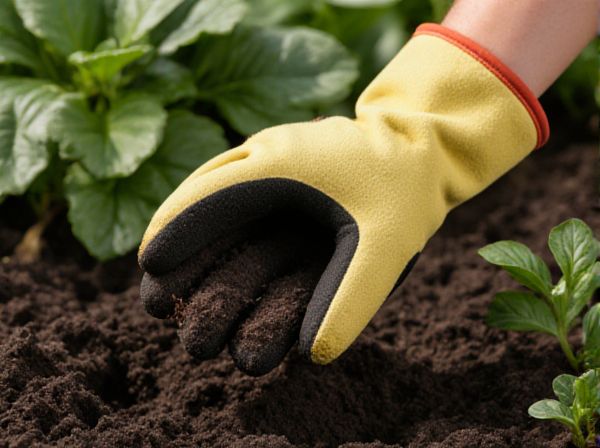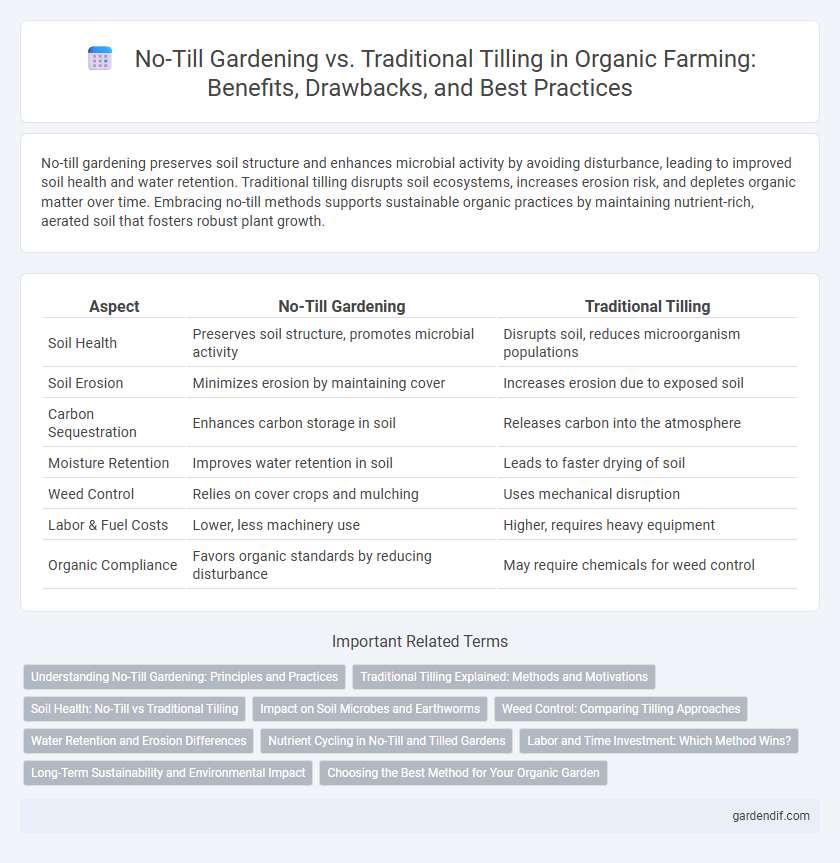
No-till gardening vs traditional tilling Illustration
No-till gardening preserves soil structure and enhances microbial activity by avoiding disturbance, leading to improved soil health and water retention. Traditional tilling disrupts soil ecosystems, increases erosion risk, and depletes organic matter over time. Embracing no-till methods supports sustainable organic practices by maintaining nutrient-rich, aerated soil that fosters robust plant growth.
Table of Comparison
| Aspect | No-Till Gardening | Traditional Tilling |
|---|---|---|
| Soil Health | Preserves soil structure, promotes microbial activity | Disrupts soil, reduces microorganism populations |
| Soil Erosion | Minimizes erosion by maintaining cover | Increases erosion due to exposed soil |
| Carbon Sequestration | Enhances carbon storage in soil | Releases carbon into the atmosphere |
| Moisture Retention | Improves water retention in soil | Leads to faster drying of soil |
| Weed Control | Relies on cover crops and mulching | Uses mechanical disruption |
| Labor & Fuel Costs | Lower, less machinery use | Higher, requires heavy equipment |
| Organic Compliance | Favors organic standards by reducing disturbance | May require chemicals for weed control |
Understanding No-Till Gardening: Principles and Practices
No-till gardening preserves soil structure by eliminating disturbance from plowing or tilling, which enhances beneficial microbial activity and increases organic matter retention. This practice minimizes soil erosion and improves water infiltration, fostering a healthier root environment compared to traditional tilling methods. By maintaining soil integrity, no-till gardening supports sustainable organic farming with improved nutrient cycling and long-term soil fertility.
Traditional Tilling Explained: Methods and Motivations
Traditional tilling involves turning and breaking the soil using plows or rototillers to prepare planting beds by loosening compacted earth and incorporating organic matter. This method aims to improve aeration, control weeds, and facilitate root penetration, but may disrupt soil structure and microbial communities. Farmers and gardeners often choose traditional tilling to enhance short-term crop yields and manage soil fertility in organic and conventional systems.
Soil Health: No-Till vs Traditional Tilling
No-till gardening preserves soil structure by minimizing disturbance, leading to enhanced microbial activity, improved water retention, and reduced erosion compared to traditional tilling. Traditional tilling disrupts soil layers, destroys beneficial organisms, and accelerates organic matter decomposition, resulting in nutrient loss and degraded soil health. Maintaining no-till practices promotes long-term soil fertility and sustainability essential for organic gardening.
Impact on Soil Microbes and Earthworms
No-till gardening significantly enhances soil microbial diversity and boosts earthworm populations by preserving soil structure and organic matter, creating a thriving ecosystem. Traditional tilling disrupts these soil organisms, leading to reduced microbial activity and earthworm decline due to habitat fragmentation and increased soil exposure. Maintaining no-till practices supports nutrient cycling, promotes soil health, and improves long-term fertility in organic gardening systems.
Weed Control: Comparing Tilling Approaches
No-till gardening suppresses weed growth by preserving soil structure and maintaining a protective mulch layer, reducing soil disturbance that often brings weed seeds to the surface in traditional tilling. Traditional tilling exposes dormant weed seeds to sunlight and air, encouraging germination and increasing weed pressure. Organic no-till methods enhance weed control while promoting beneficial soil microbes, leading to healthier plant growth.
Water Retention and Erosion Differences
No-till gardening significantly improves soil water retention by preserving soil structure and organic matter, allowing moisture to penetrate and remain longer compared to traditional tilling, which disrupts soil aggregates and accelerates evaporation. Traditional tilling exposes soil to air and sun, increasing erosion risk by loosening topsoil and making it more susceptible to runoff during rainfall. No-till practices reduce erosion by maintaining a protective residue layer on the soil surface, stabilizing the soil and promoting healthier root systems.
Nutrient Cycling in No-Till and Tilled Gardens
No-till gardening enhances nutrient cycling by preserving soil structure and microbial activity, which facilitates organic matter decomposition and nutrient retention. Traditional tilling disrupts soil layers, leading to increased nutrient leaching and diminished microbial biodiversity, impairing natural nutrient cycling processes. Maintaining intact soil ecosystems in no-till gardens promotes efficient nutrient availability and long-term soil fertility.
Labor and Time Investment: Which Method Wins?
No-till gardening significantly reduces labor by eliminating the need for intensive soil turning, saving gardeners hours typically spent on digging and preparing beds. Traditional tilling requires frequent mechanical or manual intervention to aerate and mix soil, increasing physical effort and time investment. Choosing no-till methods boosts efficiency while promoting soil health, making it a labor- and time-conscious option for organic gardeners.
Long-Term Sustainability and Environmental Impact
No-till gardening significantly enhances long-term sustainability by preserving soil structure, increasing organic matter, and promoting biodiversity compared to traditional tilling methods. It reduces soil erosion and carbon release, supporting healthier ecosystems and mitigating climate change. Maintaining soil integrity with no-till practices fosters resilient crop growth and sustainable organic food production over time.
Choosing the Best Method for Your Organic Garden
No-till gardening preserves soil structure and microbial life by minimizing disturbance, which enhances organic matter retention and promotes healthier plant growth. Traditional tilling can improve initial soil aeration and weed control but may disrupt beneficial organisms and lead to erosion over time. Selecting the best method depends on your garden's soil type, crop needs, and commitment to sustainable practices, with no-till often favored for long-term organic soil health.
No-till gardening vs traditional tilling Infographic

 gardendif.com
gardendif.com